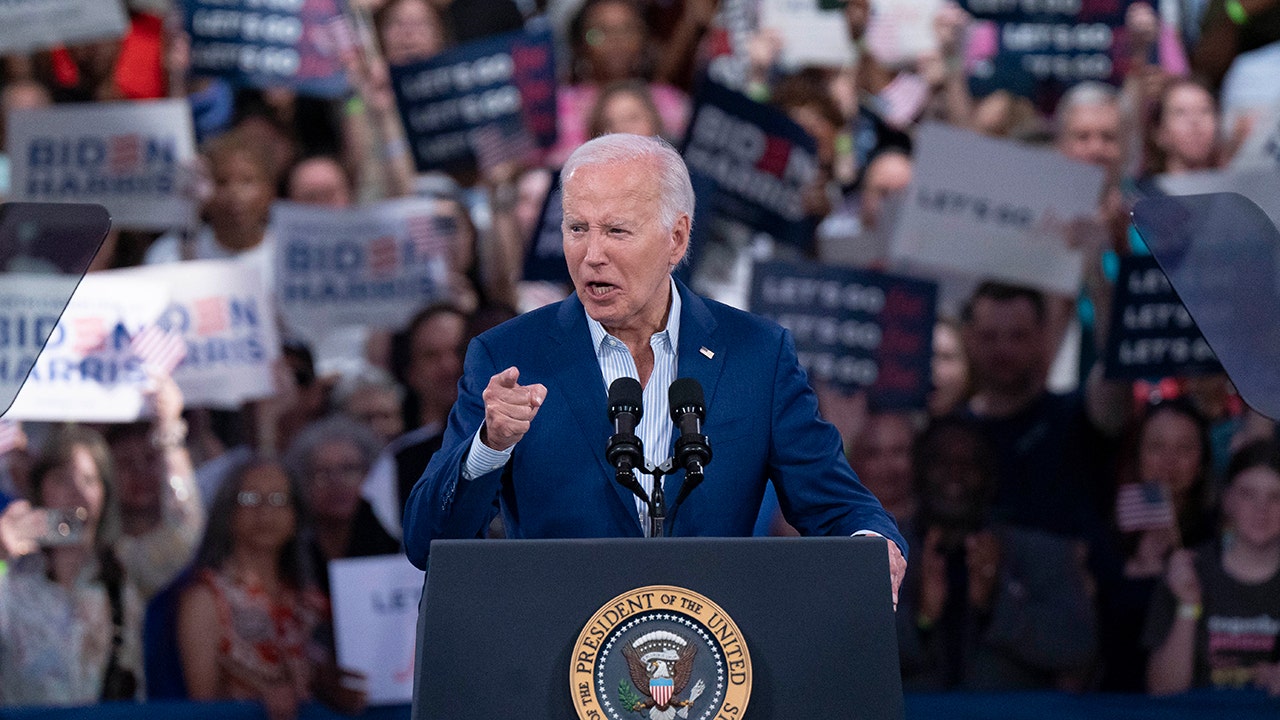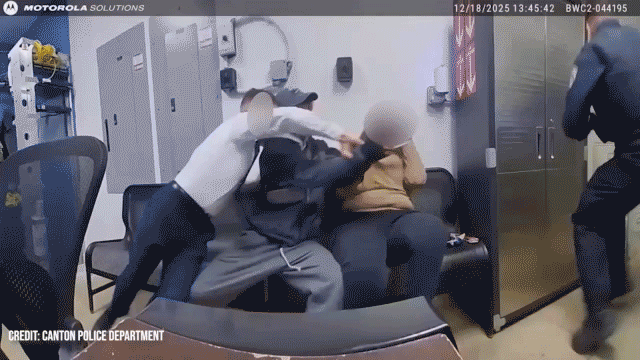Midwest
Democrats' nomination of Biden in virtual roll call could come as early as mid-July

The Democratic National Committee is considering formally nominating President Biden as early as mid-July, two Democratic sources confirm to Fox News.
A potential date for Biden’s nomination is July 21, which is when the Democratic National Convention’s credentials committee meets virtually.
As has been reported for weeks, Democratic Party officials decided that the formal roll call would not take place at their convention, which kicks off on August 19th in Chicago.
BIDEN TRIES TO FLIP THE SCRIPT ON THE NEGATIVE NARRATIVE COMING OUT OF THE DEBATE
President Biden speaks at a post-debate campaign rally on June 28, 2024, in Raleigh, North Carolina. (Allison Joyce/Getty Images)
The reason is that the Democrats’ convention comes after Ohio’s ballot deadline of August 7th. Party officials, in a maneuver to allow Biden to appear on the Ohio ballot, said they would hold the roll call ahead of Ohio’s ballot deadline.
But the latest development on a potential July 21 roll call date also comes in the wake of last Thursday’s disastrous debate performance by the president in his first face-to-face showdown with former President Trump.
President Biden and former President Trump debated on Thursday night. (Getty Images)
The 81-year-old president’s halting delivery and stumbling answers at the debate sparked widespread panic in the Democratic Party and spurred calls from political pundits, editorial writers, and some party politicians and donors, for Biden to step aside as the party’s standard-bearer.
Word of the potential July 21 roll wall was first reported by Bloomberg News.
Get the latest updates from the 2024 campaign trail, exclusive interviews and more at our Fox News Digital election hub.
Read the full article from Here

Midwest
Gun jams as shoplifting suspect tries to shoot Ohio police officer at point-blank range in wild bodycam video

NEWYou can now listen to Fox News articles!
Heart-pounding video shows the moment a shoplifting suspect allegedly tried to shoot an Ohio police officer at point-blank range inside a Walmart only to be stopped when his gun appeared to malfunction and a store security worker intervened.
The dramatic incident unfolded Thursday in Canton after the suspect and a woman were detained for allegedly stealing items from the store, according to reports.
The pair were taken to a security room, where a police officer is seen questioning and searching the male suspect, identified as Shane Newman, 21, by FOX 8.
Video from the officer’s body camera, which had been placed on a table, initially showed a calm scene, with a Walmart employee handing the officer a pen and paper as the two suspects sat on a bench.
UNIVERSITY OF DELAWARE STUDENT ALLEGEDLY MAPPED OUT ATTACK ON CAMPUS POLICE; ILLEGAL WEAPONS RECOVERED
A Walmart security employee lunges at an armed shoplifting suspect inside a store security room in Ohio after the suspect attempted to fire a gun at a police officer, video footage shows. (Canton Police Department)
Moments later, the situation exploded.
Newman suddenly turned, pulled out a gun and attempted to shoot the officer as the woman screamed, “No, no, no!” A clicking sound could be heard as Newman apparently pulled the trigger.
The Walmart worker immediately jumped on Newman in an effort to restrain him, but Newman raised the gun again and attempted to fire a second time and another click could be heard.
The worker then knocked the gun from Newman’s hands as the officer drew his weapon and shouted, “Get back! Get back!”
The officer then took control of matters and pinned Newman to the floor until additional police arrived. Both suspects were taken into custody.
In the bodycam footage, the officer told responding police Newman had “pulled the gun out, pointed it at my head and pulled the trigger,” but the weapon did not fire.
NORTH CAROLINA POLICE OFFICER KILLED IN LINE OF DUTY DURING EMERGENCY ROOM SHOOTING INCIDENT
A Walmart security worker and a police officer restrain a shoplifting suspect inside a store security room in Ohio after police say the suspect attempted to shoot the officer, body camera footage shows. (Canton Police Department)
The officer said he drew his own weapon and would have shot Newman but feared hitting the Walmart employee as the worker struggled to disarm the suspect. He also acknowledged missing the gun concealed in Newman’s shoulder bag during the initial search.
The officer said he had just been alerted seconds before the attack that Newman had an active warrant for his arrest and was classified as “armed and dangerous.”
Newman was charged with attempted murder and felonious assault on a police officer, court records show.
The woman, identified as Katerina Jeffrey, was charged with complicity to commit robbery and having weapons under disability for possession of ammunition, FOX 8 reported.
Bodycam images show Shane Newman inside a Walmart security room in Ohio shortly before police say he pulled a gun and attempted to shoot an officer. Newman is seen holding a small red container that investigators said contained illegal drugs. (Canton Police Department)
Before the violence erupted, the police officer asked Newman if he had anything on him as part of the search. Newman said all he had was a cellphone, and then he voluntarily handed over a small container from his pocket that investigators said contained illegal drugs, according to FOX 8.
CLICK HERE TO DOWNLOAD THE FOX NEWS APP
“Are we going to jail?” Jeffrey asked the police officer.
“Not unless something crazy happens,” the officer replied.
Read the full article from Here
Detroit, MI
Detroit Lions WR Amon-Ra St. Brown dealing with knee injury

Lions QB Jared Goff on controversial final play vs Steelers
Goff said he didn’t agree with the pass interference call made on receiver Isaac TeSlaa in the final minute of the game, Dec. 21, 2025.
Detroit Lions wide receiver Amon-Ra St. Brown is dealing with a knee injury, though Lions coach Dan Campbell indicated he does not believe it’s serious.
St. Brown was listed as a non-participant on the Lions’ estimated practice report Monday, Dec. 22.
The Lions held a walk-through Monday in advance of this week’s game against the Minnesota Vikings on Thursday (4:30 p.m., Netflix). Campbell said St. Brown showed up to the practice facility after the team’s loss to the Pittsburgh Steelers and reported the injury.
“We’ll know more a little bit later but this is just something that just popped up when he came in today,” Campbell said. “So hopeful this is something [that’s] just some type of irritation from the game. That’s what I’m hoping.”
St. Brown leads the Lions with 98 catches, 1,194 yards and 11 touchdowns and needs two catches over the Lions’ final two games for his fourth straight 100-catch season.
Taylor Decker (shoulder) and Avonte Maddox (back) also were listed as non-participants on Monday’s practice report, and the Lions listed nine others as limited participants including starters Marcus Davenport (shoulder), Graham Glasgow (knee), Christian Mahogany (fibula), Alim McNeill (abdomen) and Amik Robertson (hand).
The Lions (8-7) must win their final two games and have the Green Bay Packers (9-5-1) lose their final two games to make the playoffs.
Dave Birkett covers the Lions for the Detroit Free Press. Contact him at dbirkett@freepress.com. Follow him on Bluesky, X and Instagram at @davebirkett.
Milwaukee, WI
Milwaukee daycare van stolen with kids inside; 27-year-old woman accused

MILWAUKEE – A 27-year-old Milwaukee woman is accused of stealing a running daycare van that had four young children inside. The accused is Katelyn Librizzi – and she faces the following criminal counts:
- Operating a motor vehicle without owner’s consent
- Abduction of a child
Case details
What we know:
According to the criminal complaint, a Milwaukee police detective responded around 4 p.m. on Tuesday, Dec. 16 to an abduction investigation near Appleton and Burleigh. A 911 call came from the owner of a daycare center indicating that a woman “jumped into her van and pulled off with her children inside,” the complaint says. That second person was later identified as Katelyn Librizzi, the defendant.
FREE DOWNLOAD: Get breaking news alerts in the FOX LOCAL Mobile app for iOS or Android
A short time later, Milwaukee police conducted a high-risk traffic stop. The defendant was the driver and was arrested. The complaint says four young children were seated inside the van.
When police spoke with the daycare owner, she said she called 911 from the daycare because her personal cellphone was in the van that had been stolen.
Inside the recovered van, police found medical documents listed to the defendant, the complaint says. Investigators also used the daycare owner’s cellphone to get geolocation data, which showed the van’s path.
On Dec. 17, a detective interviewed the defendant who “indicated she had mental health issues,” the complaint says. The detective also reported Librizzi “was making statements and comments that are not typically mentioned in interviews,” the complaint says. Librizzi also told police “she had been driving and saw little kids in the back of the vehicle. The defendant also reported that the police pulled her over. She reported that the can had been running in front of a daycare,” the complaint says.
SIGN UP TODAY: Get daily headlines, breaking news emails from FOX6 News
What’s next:
Librizzi appeared in Milwaukee County court on Sunday, Dec. 21. Cash bond was set at $10,000. The court also ordered Librizzi to undergo a competency examination.
The Source: Information in this post was provided by Wisconsin Circuit Court Access and the criminal complaint associated with this case.
-

 Iowa1 week ago
Iowa1 week agoAddy Brown motivated to step up in Audi Crooks’ absence vs. UNI
-

 Iowa1 week ago
Iowa1 week agoHow much snow did Iowa get? See Iowa’s latest snowfall totals
-

 Maine6 days ago
Maine6 days agoElementary-aged student killed in school bus crash in southern Maine
-

 Maryland1 week ago
Maryland1 week agoFrigid temperatures to start the week in Maryland
-

 New Mexico6 days ago
New Mexico6 days agoFamily clarifies why they believe missing New Mexico man is dead
-

 South Dakota1 week ago
South Dakota1 week agoNature: Snow in South Dakota
-

 Detroit, MI1 week ago
Detroit, MI1 week ago‘Love being a pedo’: Metro Detroit doctor, attorney, therapist accused in web of child porn chats
-

 Maine6 days ago
Maine6 days agoFamily in Maine host food pantry for deer | Hand Off












